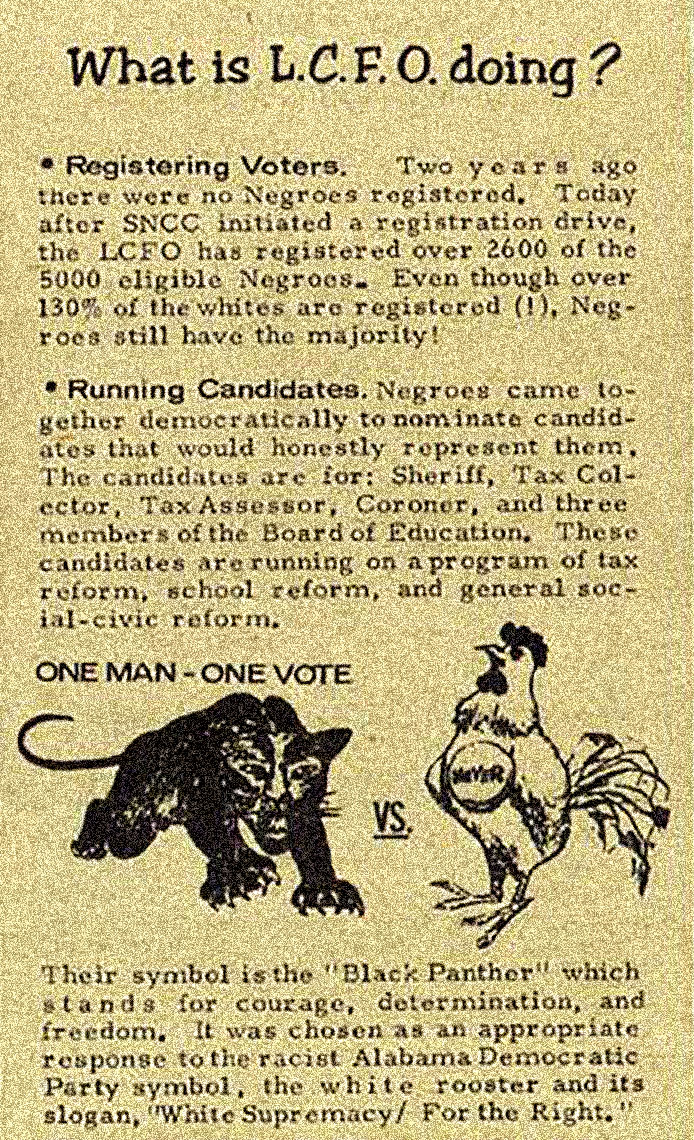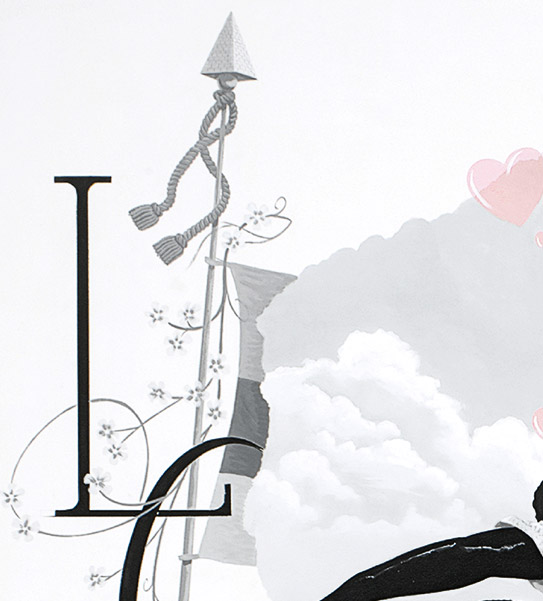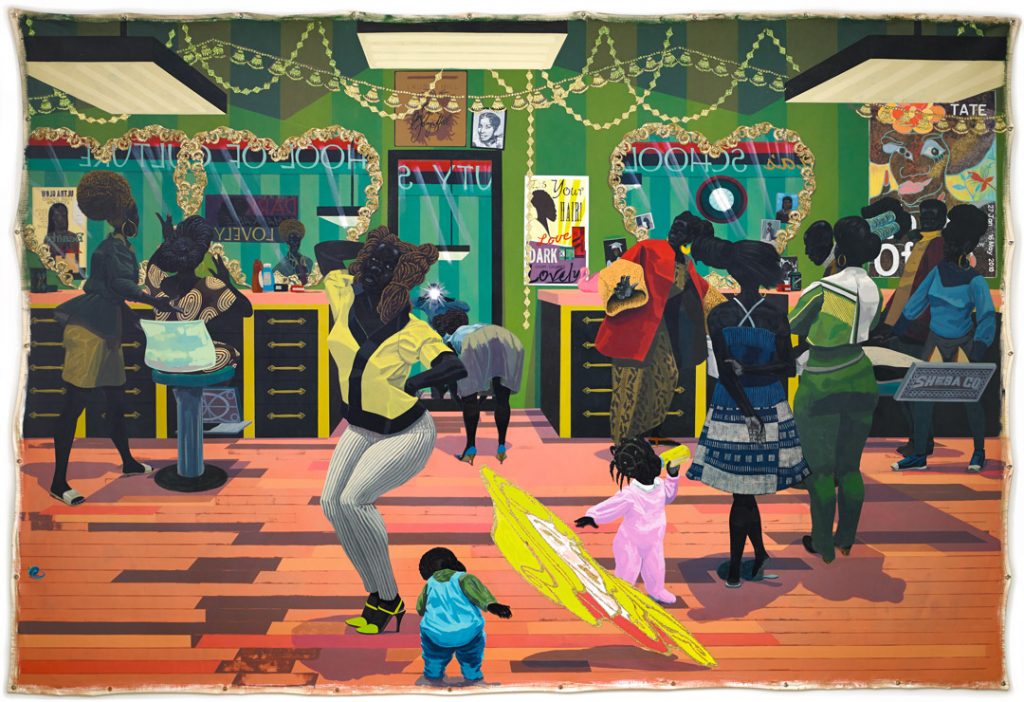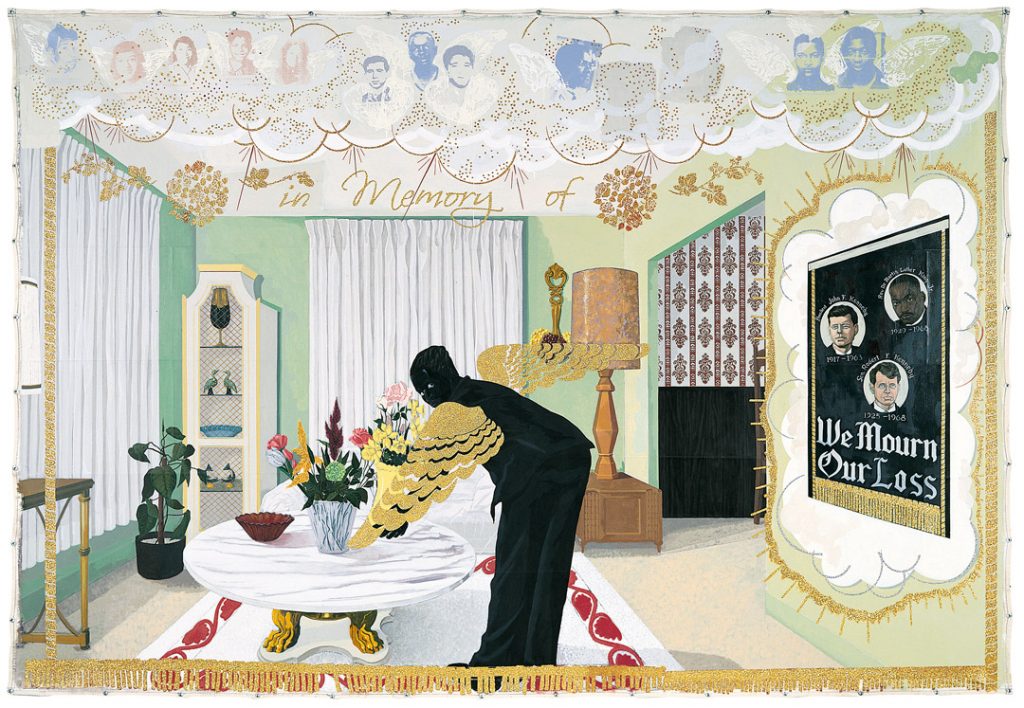Vignette #2.75
Kerry James Marshall
Romantic courtship defined by luxury and careless abundance were popular themes in 18th-century Rococo paintings in France. Marshall’s Vignette series references The Swing, Jean-Honoré Fragonard’s painting from 1767. Rather than a swing hung in a tree, Marshall creates a visual pun with this 360-degree swing in the air by the couple. Like the details of the garden setting surrounding the wealthy couple in Fragonard’s painting, Marshall’s couple is surrounded by details that refer to social standing and Black history. Depictions of Black romance and courtship are rare, which is why Marshall singles it out as important to represent.

Interior panel of brochure for the Lowndes County (Alabama) Freedom Organization, circa October 1966, from the H. K. Yuen Social Movement Archives at UC Berkeley.
A key symbol of the revolutionary nationalist and socialist Black Panther Party in 1966, the Panther originated in Jim Crow-era Alabama, the state where Marshall was born. In response to the Alabama Democratic Party symbol of the white rooster, the Lowndes County Freedom Organization adopted the panther as the logo for their efforts to register Black voters.
"When you look at a lot of the paintings that led up to rococo painting there's some features that seem to be reocurring in all of those works. There's a kind of evocation of the classical ideal of love . . . I started replacing some of that imagery with a kind of classical ideal of Black independence and Black nationalism."
– Kerry James Marshall
The closed fist is a symbol of solidarity, strength, and defiance. It became a sign for the Black Power Movement in 1968, the year Martin Luther King Jr. and Robert Kennedy were assassinated. At the Olympics of that same year, African American athletes Tommie Smith and John Carlos wore black gloves and raised their fists while accepting their medals. Tommie Smith and John Carlos won gold and bronze in the 200-meter sprint. Smith set a new world record in this race.

Vignette #2.75 (detail), 2008, Kerry James Marshall
Painted in gray tones, these subtle stripes may depict the Pan-African flag. The Rococo-style cloud becomes more prominent than the flag, since we don’t have enough visual information to say whose flag this is and if it is ripped, or merely covered. This is one way the painting emphasizes the personal over the political and addresses the complex history of Black romance in America.

More Kerry James Marshall
Images: Vignette #2.75, 2008, Kerry James Marshall, acrylic on PVC panel, 73 ¼ x 61 in., The Art Institute of Chicago, Through prior gift of Adeline Yates; Benjamin Argile Memorial, Cyrus Hall McCormick, Alfred and May Tiefenbronner Memorial, Mr. and Mrs. Frank G. Logan Prize, Pauline Palmer Prize, Broadus James Clarke Memorial, Norman Wait Harris Prize, William H. Bartels Prize, Joyce Van Pilsum, Laura T. Magnuson Acquisition, Ann M. Vielehr Prize, and Ada S. Garrett Prize funds; Flora Mayer Witkowsky Award for American Art; Boles C. and Hyacinth G. Drechney and Mr. and Mrs. J.F. Brower Prize funds; The Municipal Art League Prize for Portraiture; Marjorie and Louis Susman, Martin B. Cahn Prize, and Elisabeth Mathews funds, 2008.481.4, © Kerry James Marshall, The Art Institute of Chicago / Art Resource, NY. School of Beauty, School of Culture, 2012, Kerry James Marshall, acrylic and glitter on unstretched canvas, 108 x 158 in., Birmingham Museum of Art, Museum purchase with funds provided by Elizabeth (Bibby) Smith, the Collectors Circle for Contemporary Art, Jane Comer, the Sankofa Society, and general acquisition funds, 2012.57, © Kerry James Marshall. Souvenir I, 1997, Kerry James Marshall, acrylic, collage, and glitter on unstretched canvas, 108 x 157 in., Collection Museum of Contemporary Art Chicago, Bernice and Kenneth Newberger Fund, 1997.73, © MCA Chicago, photo: Joe Ziolkowski.




